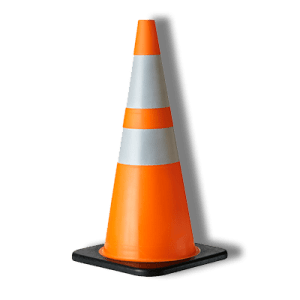How far is 10 metres?
Learn how to shuffle away 10 metres from a downed or damaged power line by imagining a school bus to estimate the distance.

Overview
Practice Down. Danger. Dial. to stay safe around power lines and learn how to shuffle 10 metres to safety. Imagining a school bus as a guide, students will estimate, and measure 10 metres while learning that 10 metres is a safe distance to move away from a fallen or hazardous power line.
Instructions
What you'll need
- "How far is 10 metres" colouring sheet, print one copy per student
- Colouring crayons or markers, and scissors for each student
- Measuring tape or a metre stick
- Chalk or something to mark a spot on the ground like a rock, per student
Fill in the blanks
- Do the activity “Safe or unsafe” and/or have a class discussion about electricity, how it travels through power lines outdoors, and how to spot dangerous and unsafe situations with power lines. Remind students of Down. Danger. Dial 911; that if a power line is DOWN, it’s a DANGER, so you must stay away and DIAL 911.
- Provide each student with a “How far is 10 metres” colouring sheet. Ask students to colour the picture and fill in the blanks for Down. Danger. Dial.
How long is a school bus?
- Power down the classroom, bring a measuring tape or a metre stick to measure 10 metres, and find a large area, such as outdoors or the gym. Explain that if there is a downed or damaged power line you need to stay away a minimum of 10 metres and if closer move away by shuffling your feet till you are 10 metres away. Share that a school bus is 10 metres long.
- Have students spread out behind a line like in a basketball court. Ask students to close their eyes and imagine the length of a school bus. Ask them to open their eyes and shuffle forward imagining they are starting at the back of the bus and moving to the front. Ask them to stop when they think they are at the front and have moved 10 metres. Using chalk or a small rock have students mark this spot.
- As a class measure how far they have moved. See who is 10 metres (or more) away and emphasize that this is the safe distance from a downed or damaged power line.
- Repeat this exercise in a different area, re-measure and see if students are estimating 10 metres more accurately.
- Review with students that electricity powers our homes and schools and that it’s safe for us to use provided we pay attention. We must observe any dangerous situations, like fallen power lines, and remember Down. Danger. Dial and shuffle at least 10 metres away before dialling 911.
Modify or extend this activity
Extension
- Pull up the “Winter storm safety” activity to learn more about electricity, safety and be ready for power outages.
Curriculum Fit
Grade K, 1 Physical and Health Education
Content
- Hazards and potentially unsafe situations
Curricular competency
Social and community health
- Identify and describe a variety of unsafe and/or uncomfortable situations
Grade K, 1 Arts Education
Big ideas
- Dance, drama, music, and visual arts express meaning in unique ways
Content
- Visual arts: elements of design: line, shape, texture, colour; principles of design: pattern, repetition
Curricular competency
Exploring and creating
- Explore elements, processes, materials, movements, technologies, tools, and techniques of the arts
Grade K, 1 English Language Arts
Big ideas
- Stories and other texts can be shared through pictures and words
Curricular competencies
Comprehend and connect
- Use sources of information and prior knowledge to make meaning
- Use developmentally appropriate reading, listening and viewing to make meaning
Grade K, 1 Mathematics
Big ideas
- Objects have attributes that can be described, measured, and compared
Curricular competencies
Reasoning and analyzing
- Estimate reasonably
Understanding and solving
- Develop, demonstrate, and apply mathematical understanding through play, inquiry, and problem solving
- Visualize to explore mathematical concepts
Assessments
- Assess students’ ability to identify safe and dangerous situations around power lines.
- Assess students’ knowledge of "Down. Danger. Dial" and to call 911 if they see a fallen or damaged power line.
Assess students’ ability to shuffle 10 metres away from a downed power line, and estimate approximately 10 metre distance.
Teaching Notes
Electrical safety tips around power lines
- Don't climb on power poles
- Never fly kites near power lines
- Stay away from broken or fallen power lines
- Never touch or climb trees that are near power lines
- Never touch big, metal transformer boxes with warning signs
- Obey warning signs
- Stay away from substations and power lines
Electrical safety, electricity and power lines
Power lines are conductive meaning the electrical current runs through them with the least resistance. However if something makes contact with a live power line like a tree, kite, or ladder, the electrical current may flow to the ground. The place where the current touches the ground is the highest voltage and from that point the electrical current spreads out in irregular concentric circles. The voltage or electrical intensity decreases as it moves further from the source. A safe distance from the source of contact, like a downed power line, is 10 metres or more.
Electricity has the ability to find its way through touch to get to the ground. If a kite gets tangled in a power line, the electrical current could travel through the kite and you to reach the ground. Birds do not get zapped when standing on a power line, however they would if they straddled two power lines, or touch their beak to the ground while standing on the power line.
If there is a power line on the ground, you need to move away from the source (where it touches the ground). However electricity has the ability to move through your body as you step away from the source of electricity. As electrical current flows through the ground the voltage decreases in concentric rings or ripples as you move further from the source. So, if you move away by lifting one foot, the change in voltage between the concentric rings can travel up one leg and down the other. Instead by keeping your legs together and shuffling your feet, the electrical current will stay in the ground. 10 metres is the safe distance calculated based on the voltage in the power lines here in B.C.







